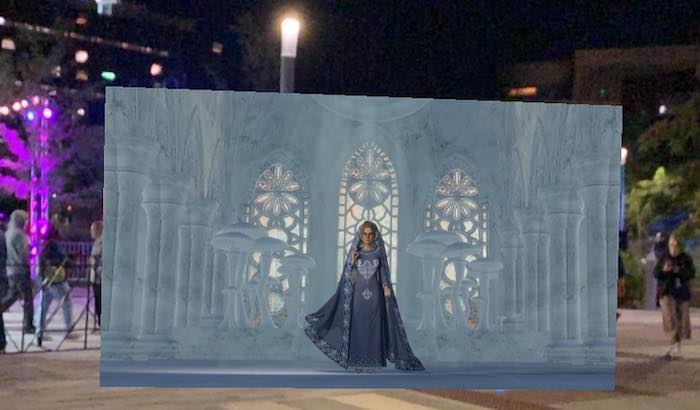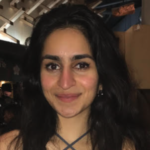
“When two camps that are usually at the polar ends of the spectrum start talking, things happen.”
Inside a nondescript white tent among brick buildings, a celebration of color, culture and creativity erupted in Kendall Square over the weekend. The House of Nahdra had arrived to help kick off Boston Fashion Week in style.
Models wearing colorful, futuristic outfits danced and power-walked across a runway in the middle of a tent. African rhythms and audience cheers reverberated through the space. At one point, a model spun her way down the catwalk in a shimmery dress and golden headdress, her metallic wings rotating around her ethereally.
At the end of the show, all the models came out with whistles, blowing confidently along with the beat as the audience clapped and danced. Nahdra Ra Kiros, the designer behind the House of Nahdra and its garments, appeared for an encore.
Saturday’s runway show completed a day-long collaboration between Boston Fashion Week and Cambridge Science Festival. Celebrating the intersection between science and fashion, the event included workshops on creative upcycling, dancers in kinetic couture, an electronic textile carpet and more.
Ra Kiros said fashion’s emphasis on pattern makes it a natural extension of science.
“When I was little I thought I wanted to be a scientist, an archaeologist, or an architect, and then I realized I can do all of that with fabric and designing,” she said. “It’s a translation of patterns across many spectrums.”

Ra Kiros’ designs are “Afro-future.” She draws inspiration from both ancient cultures and futuristic elements and aims to elevate people’s energy through her clothing.
“I will explain to my models that when they are wearing the garments that I design and create, it is really to raise their vibration, my vibration, and the vibration of those viewing it,” she said. “It is a reminder of our divinity, and that we are divine, royal beings on the planet.”
Janine Adebo, a Boston-based fashion and beauty event coordinator, attended the show with her brother who works in the tech industry. She said they were both inspired by Ra Kiros’ background in both science and fashion.
“The fact that she wanted to be a scientist, then she fell in love with architecture and that visual part of her brain just kicked in makes sense to me,” Adebo said. “I think if artists—if fashion designers—and scientists sat together, I think they’d find that they could create.”
Adebo also highlighted the overall importance of two traditionally separate groups like science and art collaborating.
“When two camps that are usually at the polar ends of the spectrum start talking, things happen.”
Ganit Goldstein, a computation textile designer based in Boston, also presented her collection on Saturday. She pioneers the use of 3D printing to create custom, layered fabrics.
Goldstein brings a wide breadth of technical knowledge to her garments. She studied fashion and jewelry in Israel, traditional textile manufacturing in Japan, soft systems in London, and computational architecture at Massachusetts Institute of Technology.
Goldstein said Saturday’s collection represented a development of all the techniques she learned through the years. For example, she used 3D body scans to mimic the curves of the body and 3D printed shoulder pieces that recreated these curves on one of her garments. She then covered these pieces with textiles she made in Japan using traditional craft techniques.
Goldstein said the collection strikes a balance between technology and tradition.
“It’s kind of this illusion that I’m trying to build with the audience that it may be a super technological approach, but it has the effect of craft,” she said.
Goldstein said Boston Fashion Week’s collaboration with Cambridge Science Festival highlights the future potential of fashion tech in Boston.
“I think there is a lot of potential for this hybrid of the science world and fashion, just because there are a lot of technologies opening up here, especially at MIT,” Goldstein said. “That’s why I’m so excited to be a part of it, because the fashion aspect is sometimes not connected to science.”
Saturday’s science-focused collaboration marked the first day of Boston Fashion Week, an annual fashion event that first started in 1995. Over the past 27 years, it has highlighted both up-and-coming designers and well-established professionals.
This year, Boston Fashion Week runs through Oct. 15 and will focus on a new theme each day. These include science, gender, cultural diversity, age, sustainability, art and craft, inclusion and buying local. Augmented reality galleries in public places all around the city enhance the event. Viewers can go to specific locations and view collections pertaining to each day’s theme through their phone.
Jay Calderin, founder and director of Boston Fashion Week, said the various themes spark more meaningful engagement.
“Boston Fashion Week is a civic initiative, and every year it serves as a laboratory for ideas,” he said. “We wanted our audiences to be discussing more than the latest trends.”
For Ra Kiros, participating in Boston Fashion Week gave her career the kickstart it needed to succeed. The first time she showed her designs at the event, she was a teenager just entering the industry.
“I remember just feeling so welcomed,” she said. “Boston Fashion Week has been the ace with helping new designers and really supporting new designers and guiding the way.”
Ra Kiros also commended Boston Fashion Week for cultivating the city’s artistic community.
“Jay and the team have always put together an amazing umbrella of designers and a comfortable yet educational outlet,” she said. “It’s like a big hug.”
Calderin said honoring Boston’s regional culture plays an important role in Boston Fashion Week’s success.
“Authenticity is key,” he said. “We would never want to pretend to be anything other than who and what we are.”
At Boston Fashion Week, prioritizing authenticity means taking advantage of the city’s many educational institutions. It means collaborating with local partners like the Cambridge Science Festival.
It also means linking fashion to science, broadening fashion’s scope in the process.
Asked how he would characterize the Hub scene, Calderin replied, “We think our tagline says it all. Boston fashion is smart.”
bostonfashionweek.com
Sujena Soumyanath is a journalist interested in fashion, politics and global affairs. She enjoys learning new languages and reading Murakami.

